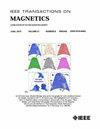A Modified Two-Phase Model to Address the Magnetization Reversal Mechanism and Angular Dependence of Coercivity in Conical Wire–Tube Heterostructures
IF 1.9
3区 工程技术
Q3 ENGINEERING, ELECTRICAL & ELECTRONIC
引用次数: 0
Abstract
Integrating different geometries into a single nanostructure paves the way to obtain magnetic properties available in both isolated geometries. Wire and tube nanostructures are among the most explored morphologies in the ferromagnetic cylindrical structure area. This work examines wire–tube heterostructures with the inclusion of bulged and tapered diameter modulations, which enhance the control over static magnetic properties. An extra step is observed in the hysteresis loops corresponding to the switching originated initially in the tube region, followed by the wire region. The pinning of the domain wall at the wire–tube interface can also be observed. Remanent states show that vortex domain walls can be nucleated at the ends along with the interface, depending on the radius and the type of modulation. The core region of the vortex configuration is shifted for low values of radius, resulting in a unique arrangement of spins just before reversal. Angular variation of coercivity dictates that the reversal mechanism follows propagation of domain walls along with rotation to initially switch the spins in the tube region and later in the wire region till a certain critical angle. Later, the entire wire–tube structure shows pseudocoherent rotation. A modified two-phase (MTP) model is formulated to fit the simulated data of angular coercivity below the critical angle. Above the critical angle, the Stoner–Wohlfarth (SW) model fits well with simulated data. It has been demonstrated that in the case of extremely tapered wire–tube structures, the critical angle is almost nonexistent, and the MTP model explains the reversal mechanism at all field inclinations.一种改进的两相模型,用于解决锥形线管异质结构中磁化逆转机制和矫顽力角依赖性的问题
将不同的几何形状集成到一个纳米结构中,为获得两种孤立几何形状的磁性铺平了道路。线状和管状纳米结构是铁磁圆柱形结构领域中研究最多的形态。这项工作考察了包含凸起和锥形直径调制的线管异质结构,这增强了对静态磁性能的控制。在滞后回路中观察到一个额外的步骤,对应于最初起源于管区域的开关,然后是导线区域。在线管界面处还可以观察到畴壁的钉住现象。残余态表明,根据调制半径和调制类型的不同,沿界面的末端涡畴壁可以成核。涡旋结构的核心区域在半径较低的情况下发生了移位,从而在反转之前形成了独特的自旋排列。矫顽力的角度变化表明,反转机制是随着畴壁随旋转的传播,先在管区切换自旋,然后在丝区切换自旋,直到达到一定的临界角。随后,整个线管结构呈现伪相干旋转。为了拟合临界角以下角矫顽力的模拟数据,建立了修正的两相模型。在临界角以上,Stoner-Wohlfarth (SW)模型与模拟数据拟合较好。结果表明,在极锥形线管结构中,临界角度几乎不存在,MTP模型解释了所有场倾角下的反转机制。
本文章由计算机程序翻译,如有差异,请以英文原文为准。
求助全文
约1分钟内获得全文
求助全文
来源期刊

IEEE Transactions on Magnetics
工程技术-工程:电子与电气
CiteScore
4.00
自引率
14.30%
发文量
565
审稿时长
4.1 months
期刊介绍:
Science and technology related to the basic physics and engineering of magnetism, magnetic materials, applied magnetics, magnetic devices, and magnetic data storage. The IEEE Transactions on Magnetics publishes scholarly articles of archival value as well as tutorial expositions and critical reviews of classical subjects and topics of current interest.
 求助内容:
求助内容: 应助结果提醒方式:
应助结果提醒方式:


